Tamiya 1/48 F4U-1D Corsair
By Tom Cleaver
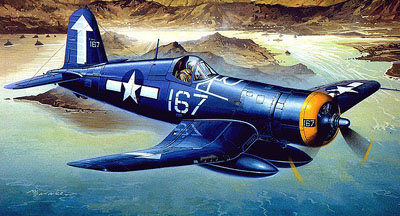 |
|
The F4U-1D was the fully-developed Corsair that the Navy had wanted when it first ordered Chance-Vought's radical fighter design into production in 1941. The airplane was finally de-bounced and made carrier-compatible; while it was still known as "The Ensign Eliminator" in recognition that it was a handful for most young Naval Aviators in comparison with the much more docile Hellcat, it definitely came along at the right time, providing a one-two punch the Navy needed to write "finis" to the Pacific War. While the F4U-1D was an even-better air-superiority fighter than its two predecessors, the F4U-1 and F4U-1A, it was also a fully-developed fighter-bomber, able to fire the equivalent of a destroyer's broadside when it cut loose with the eight 5" HVARs it now carried, as well as up to two 1,000-pound bombs on the designed-in center wing racks. Once freed of underwing ordnance, the new Corsair could more than hold its own with the newer Japanese fighters like the N1K2-J "George" or the Ki-84 "Frank." Cleared for production in April 1944, the F4U-1D equipped the Marine fighter squadrons the Navy was forced to bring aboard the fast carriers to increase the fleet's fighter strength in the face of the deadly and terrifying "divine wind" of the Kamikazes after the invasion of the Philippines in 1944. In the Spring and Summer of 1945, the airplane would become known as "The Sweetheart of Okinawa" to the American ground troops assigned the horrific task of taking this last island bastion from its diehard Japanese defenders. Anyone who checked out the Tamiya F4U-1 "birdcage" Corsair released in 1996 knew that it was engineered to provide further versions of the F4U-1 series of Tamiya's newly released F4U-1D doubles the number of totally-accurate Corsair models available in 1/48 scale. The new kit provides both styles of bubble canopy - the earlier version utilized by the F4U-1A and the early F4U-1D, and the later clear bubble of the F4U-1D. Out of the box, however, the kit is definitely a late production F4U-1D, since it comes with the slightly smaller propeller introduced about a third of the way into F4U-1D production; in fact, the early canopy provided cannot really be used with the late-version propeller. However, modelers with any propellers from the old Otaki Corsair in their spares box can meet this problem of creating an F4U-1A with no difficulty. As with the earlier F4U-1/2, the new kit can also be built with folding wings, a very welcome option indeed. So far as fit is concerned, anyone who has built the earlier model knows this is one of the best-engineered kits available from any kit manufacturer. Fit is superb, with no
The decal sheet provides three options, all F4U-1Ds: A VF-84 Corsair aboard USS "Bunker Hill" during the first Tokyo strikes of February, 1945, a VMF-112 Corsair aboard USS "Bennington" in January 1945, or CAPT Phil DeLong's well-known "F-107" at MCAS Cherry Point in 1945. With the wealth of aftermarket decals I for one hope that there will be some sheets out for the other major Corsair operator, the Fleet Air Arm. At present, the only FAA options I am aware of is an anonymous Corsair IV with a combination of British Far Eastern Fleet and British Pacific Fleet markings, and an older sheet from Arrow Graphics in Canada which provides markings for the Corsair IV flown by Robert Hampton Gray, RCNVR, the only member of the Royal Canadian Navy to be awarded the Victoria Cross. Being able to do the Corsair IIs flown Royal Marines Major Ronald Hay, or Sub-Lt. Donald J. Shephard, the only FAA Corsair aces of the war, would be nice. For any modeler, the Osprey book, "Corsair Aces," should provide all the inspiration necessary to create a fleet of these superb models. I am certain more than one of these will find their way into my completed model collection. |

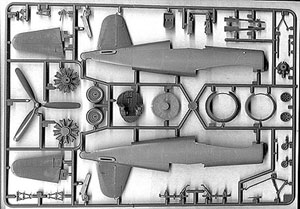 Corsair; all a modeler had to do was look at the designed-in holes in the lower wing panels where the bomb racks and rocket launcher stubs would go, and the way that the fuselage section immediately aft of the cockpit, which would change from version to version, had been designed as separate pieces, thereby allowing the main fuselage mold to go the distance without further modification. The only question was how long it would take for the F4U-1A and F4U-1D to show up. That question has now been answered: the wait is over.
Corsair; all a modeler had to do was look at the designed-in holes in the lower wing panels where the bomb racks and rocket launcher stubs would go, and the way that the fuselage section immediately aft of the cockpit, which would change from version to version, had been designed as separate pieces, thereby allowing the main fuselage mold to go the distance without further modification. The only question was how long it would take for the F4U-1A and F4U-1D to show up. That question has now been answered: the wait is over.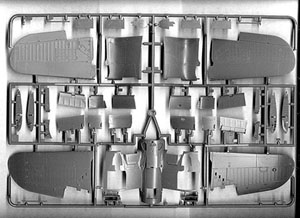 putty or other filler required. As is now de riguer with Tamiya, surface detailing is excellent: all panel lines are recessed, and the fabric effect on the rudder, elevators and outer flaps looks quite realistic. Tamiya's big failing in previous releases was that the cockpit interior detail did not rise to the level of the aircraft's exterior detail. The previous Corsair kit provided one of the best cockpits in any 1/48 kit, and this cockpit is of similar quality, with the lengthened rudder pedals and control stick to go with the 7" raise in seat position to give the pilot a fighting chance of seeing what was out ahead of Old Hognose. The decal instrument panel snugs down over the raised detail of the panel to good effect. The decal seat belt can be acceptable if done using a masking tape backing, but most serious modelers will opt for some sort of photo-etch seatbelt here. The canopy glass is a bit thick and not as clear as one might wish; however, since almost everyone will slide the canopy open, this does not create any real problem.
putty or other filler required. As is now de riguer with Tamiya, surface detailing is excellent: all panel lines are recessed, and the fabric effect on the rudder, elevators and outer flaps looks quite realistic. Tamiya's big failing in previous releases was that the cockpit interior detail did not rise to the level of the aircraft's exterior detail. The previous Corsair kit provided one of the best cockpits in any 1/48 kit, and this cockpit is of similar quality, with the lengthened rudder pedals and control stick to go with the 7" raise in seat position to give the pilot a fighting chance of seeing what was out ahead of Old Hognose. The decal instrument panel snugs down over the raised detail of the panel to good effect. The decal seat belt can be acceptable if done using a masking tape backing, but most serious modelers will opt for some sort of photo-etch seatbelt here. The canopy glass is a bit thick and not as clear as one might wish; however, since almost everyone will slide the canopy open, this does not create any real problem.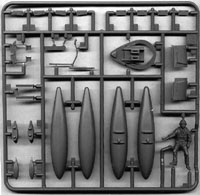 Strangely enough, the kit only provides two 154-gallon drop tanks. No bombs or rockers are provided. Furthermore, the large centerline drop tank that came with the previous kit - and which was not used by the early Corsair - is not provided here, though this is the version of Corsair that did use that item. Certainly, these are niggling points; any modeler who kept the centerline tank from the earlier kit and has a spares box can solve the problem of providing rockets and bombs. However, given that this is a Tamiya kit, this reviewer would not have expected to have to provide these items from other sources.
Strangely enough, the kit only provides two 154-gallon drop tanks. No bombs or rockers are provided. Furthermore, the large centerline drop tank that came with the previous kit - and which was not used by the early Corsair - is not provided here, though this is the version of Corsair that did use that item. Certainly, these are niggling points; any modeler who kept the centerline tank from the earlier kit and has a spares box can solve the problem of providing rockets and bombs. However, given that this is a Tamiya kit, this reviewer would not have expected to have to provide these items from other sources.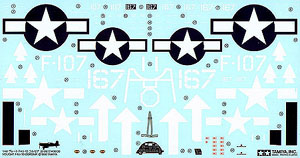 available for the F4U-1A and F4U-1D Corsairs, modelers should have their choice of interesting aircraft, so long as they like either the tri-color scheme of the F4U-1A or the overall midnight blue of the F4U-1D.
available for the F4U-1A and F4U-1D Corsairs, modelers should have their choice of interesting aircraft, so long as they like either the tri-color scheme of the F4U-1A or the overall midnight blue of the F4U-1D.